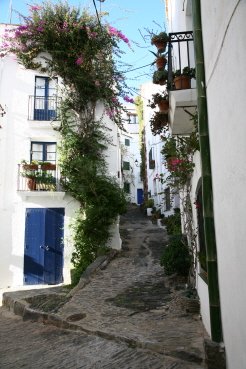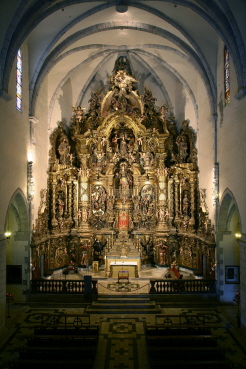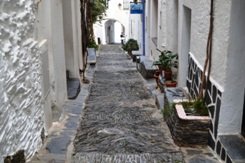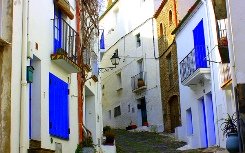Culture
Art, landscape, nature culture, tradition
- OLD TOWN and CHURCH
- MUSEUMS
- ART GALLERIES
- CULTURAL VIDEOS OF CADAQUÉS
- SCULPTURES
- EMBLEMATIC BUILDINGS
- NOTABLE VISITORS AND RESIDENTS
- FESTIVALS AND ACTIVITIES
- TOURIST BROCHURE OF CADAQUÉS
Old town and church
One of the best ways to visit Cadaqués and learn about its history is to wander around the Old Town and winding cobbled streets. Medieval town used to be walled-in and was located where the Old Town is today. Only the remains of the ancient bastion of the wall have been preserved up to today and it is part of the Town Hall. The ancient pavement, known as rastell was handmade using slate stones, can be appreciated when walking through the Old Town. Rastell has been best preserved in El Call Street. The slate stones, placed in a vertical position, were arranged following the herringbone pattern so as to absorb the excess of water and to prevent people from slipping.
Located at the highest point of the Old Town, the town's centre-piece is the church of Santa Maria with a wonderful view over the bay, Es Cucurucuc and Cala Nans lighthouse. The construction began in the middle of the 16th century and the style is mostly late Gothic. That part of the aisle nearest the façade dates from the years 1634-1640, and the "Capella Fonda" dates from the 17th. to 19th. The old church was destroyed by the Turkish pirate Barbarrosa who assaulted the village in 1543. After that, the church was rebuilt thanks to the fishermen’s contribution from fishing on bank holidays, public holidays and weekends. This event is expressed in this poem written by the local writer Frederic Rahola Trèmols:
The church in my town
Was made by fishermen
Working on public holidays
For our Lord.
The church holds the most important 18th c. baroque altarpiece (School of Vic) in Alt Empordà. It is 23m high and is dedicated to Verge de l’Esperança, a Madonna. It was designed by Jacint Moretó and made by sculptors Pau Costa and Joan Torres. During the Spanish War in 1938 built a wall in front of the altarpiece to protect it and the rest of the church was used for prisoners of war. The baroque decoration is completed with 9 other altarpieces, much smaller, in glided wood. The organ is another important piece of great patrimonial value. It was made by Josep Boscà between 1689 and 1691, and it is considered one of the oldest organs in Catalonia. Entrance is only allowed on mass days: Saturdays at 7.00pm, Sundays at 11.00am (times change depending on the season) and exceptionally when there are guided visits. It is closed on the rest of the days, although the altarpiece can be contemplated if light is used. The altarpiece from outside can be seen from 10.30am to 12.45pm and from 4.00pm to 4.45pm. Audio guides with information about the town and the church are also available.
- OLD TOWN and CHURCH
- MUSEUMS
- ART GALLERIES
- CULTURAL VIDEOS OF CADAQUÉS
- SCULPTURES
- EMBLEMATIC BUILDINGS
- NOTABLE VISITORS AND RESIDENTS
- FESTIVALS AND ACTIVITIES
- TOURIST BROCHURE OF CADAQUÉS
Old town and church
One of the best ways to visit Cadaqués and learn about its history is to wander around the Old Town and winding cobbled streets. Medieval town used to be walled-in and was located where the Old Town is today. Only the remains of the ancient bastion of the wall have been preserved up to today and it is part of the Town Hall. The ancient pavement, known as rastell was handmade using slate stones, can be appreciated when walking through the Old Town. Rastell has been best preserved in El Call Street. The slate stones, placed in a vertical position, were arranged following the herringbone pattern so as to absorb the excess of water and to prevent people from slipping.
Located at the highest point of the Old Town, the town's centre-piece is the church of Santa Maria with a wonderful view over the bay, Es Cucurucuc and Cala Nans lighthouse. The construction began in the middle of the 16th century and the style is mostly late Gothic. That part of the aisle nearest the façade dates from the years 1634-1640, and the "Capella Fonda" dates from the 17th. to 19th. The old church was destroyed by the Turkish pirate Barbarrosa who assaulted the village in 1543. After that, the church was rebuilt thanks to the fishermen’s contribution from fishing on bank holidays, public holidays and weekends. This event is expressed in this poem written by the local writer Frederic Rahola Trèmols:
The church in my town
Was made by fishermen
Working on public holidays
For our Lord.
The church holds the most important 18th c. baroque altarpiece (School of Vic) in Alt Empordà. It is 23m high and is dedicated to Verge de l’Esperança, a Madonna. It was designed by Jacint Moretó and made by sculptors Pau Costa and Joan Torres. During the Spanish War in 1938 built a wall in front of the altarpiece to protect it and the rest of the church was used for prisoners of war. The baroque decoration is completed with 9 other altarpieces, much smaller, in glided wood. The organ is another important piece of great patrimonial value. It was made by Josep Boscà between 1689 and 1691, and it is considered one of the oldest organs in Catalonia. Entrance is only allowed on mass days: Saturdays at 7.00pm, Sundays at 11.00am (times change depending on the season) and exceptionally when there are guided visits. It is closed on the rest of the days, although the altarpiece can be contemplated if light is used. The altarpiece from outside can be seen from 10.30am to 12.45pm and from 4.00pm to 4.45pm. Audio guides with information about the town and the church are also available.




